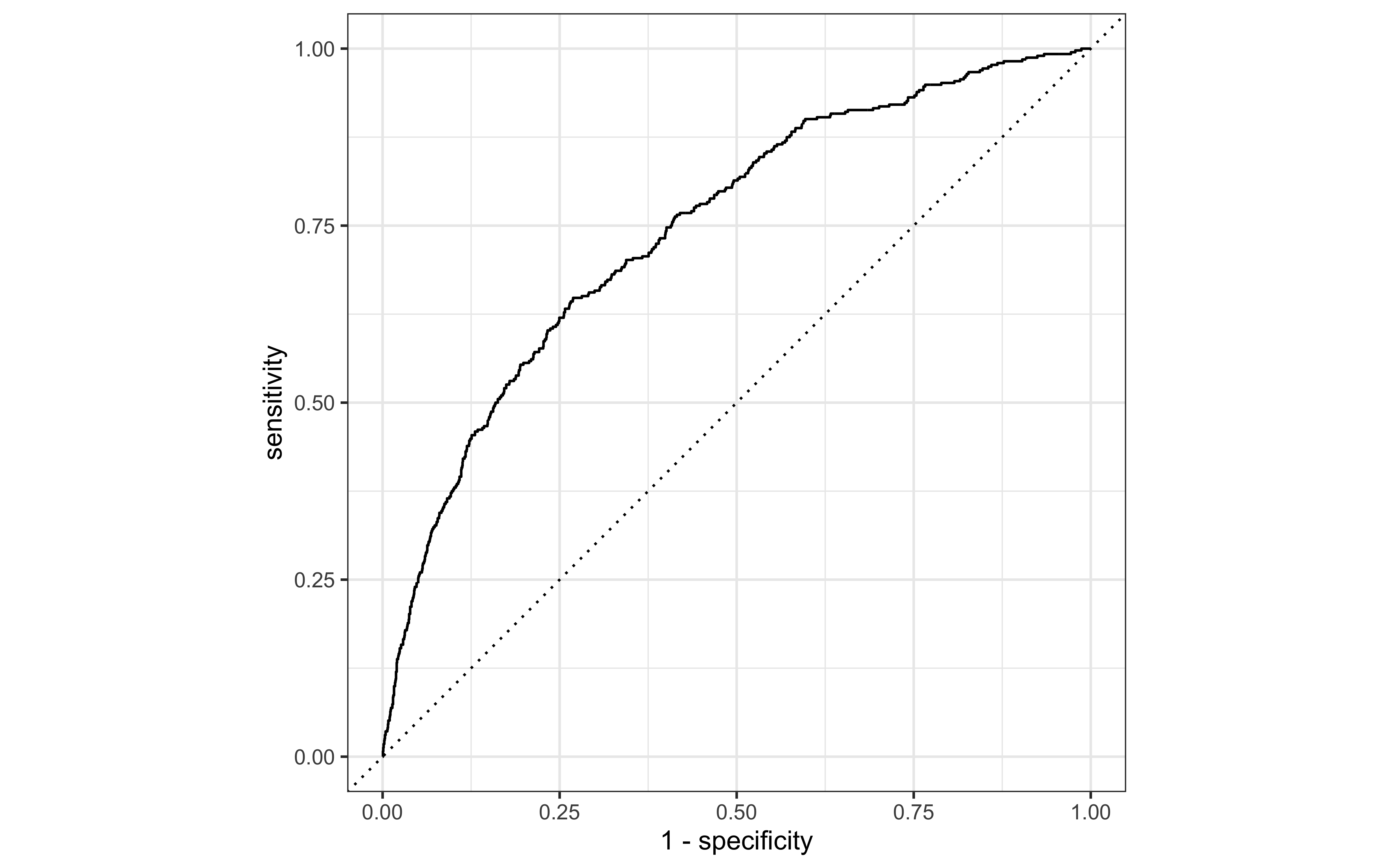Chapter 20 Prediction
The predict() method applies the recipe to the new data, then passes them to the fitted model. Let`s use the logistic regression model as an example for the next steps.
20.1 Logistic regression
predict(flights_fit_lr_mode,
test_data)## # A tibble: 2,500 x 1
## .pred_class
## <fct>
## 1 on_time
## 2 on_time
## 3 on_time
## 4 on_time
## 5 on_time
## 6 on_time
## 7 on_time
## 8 on_time
## 9 on_time
## 10 on_time
## # … with 2,490 more rowsBecause our outcome variable here is a factor, the output from predict() returns the predicted class: late versus on_time. But, let’s say we want the predicted class probabilities for each flight instead. To return those, we can specify type = "prob" when we use predict(). We’ll also bind the output with some variables from the test data and save them together:
flights_pred_lr_mod <-
predict(flights_fit_lr_mode,
test_data,
type = "prob") %>%
bind_cols(test_data %>%
select(arr_delay,
time_hour,
flight)) The data look like:
head(flights_pred_lr_mod)## # A tibble: 6 x 5
## .pred_late .pred_on_time arr_delay time_hour flight
## <dbl> <dbl> <fct> <dttm> <int>
## 1 0.0358 0.964 on_time 2013-03-04 07:00:00 4122
## 2 0.0987 0.901 on_time 2013-02-20 18:00:00 4517
## 3 0.310 0.690 on_time 2013-04-02 18:00:00 373
## 4 0.102 0.898 on_time 2013-12-10 06:00:00 4424
## 5 0.0373 0.963 on_time 2013-10-30 10:00:00 2602
## 6 0.0867 0.913 late 2013-05-25 08:00:00 3608Now that we have a tibble with our predicted class probabilities, how will we evaluate the performance of our workflow? We would like to calculate a metric that tells how well our model predicted late arrivals, compared to the true status of our outcome variable, arr_delay.
20.1.1 ROC curve
Let’s use the area under the ROC curve as our metric, computed using roc_curve() and roc_auc() from the yardstick package.
To generate a ROC curve, we need the predicted class probabilities for late and on_time, which we just calculated in the code chunk above. We can create the ROC curve with these values, using roc_curve() and then piping to the autoplot() method:
flights_pred_lr_mod %>%
roc_curve(truth = arr_delay,
.pred_late) %>%
autoplot()
20.1.2 AUC
Similarly, roc_auc() estimates the area under the curve:
flights_pred_lr_mod %>%
roc_auc(truth = arr_delay, .pred_late)## # A tibble: 1 x 3
## .metric .estimator .estimate
## <chr> <chr> <dbl>
## 1 roc_auc binary 0.74620.1.3 Accuracy
We use the metrics() function to measure the performance of the model. It will automatically choose metrics appropriate for a given type of model. The function expects a tibble that contains the actual results (truth) and what the model predicted (estimate).
flights_fit_lr_mode %>%
predict(test_data) %>%
bind_cols(test_data) %>%
metrics(truth = arr_delay,
estimate = .pred_class)## # A tibble: 2 x 3
## .metric .estimator .estimate
## <chr> <chr> <dbl>
## 1 accuracy binary 0.847
## 2 kap binary 0.18220.1.4 Recall
flights_fit_lr_mode %>%
predict(test_data) %>%
bind_cols(test_data) %>%
recall(truth = arr_delay,
estimate = .pred_class)## # A tibble: 1 x 3
## .metric .estimator .estimate
## <chr> <chr> <dbl>
## 1 recall binary 0.15320.1.5 Precision
flights_fit_lr_mode %>%
predict(test_data) %>%
bind_cols(test_data) %>%
precision(truth = arr_delay,
estimate = .pred_class)## # A tibble: 1 x 3
## .metric .estimator .estimate
## <chr> <chr> <dbl>
## 1 precision binary 0.541